Betta fish owners will witness all kinds of weird behavior.

Still, a betta that’s laying on the bottom of the tank does sound alarming.
Is the fish turned on one side or are its fins supporting its body?
Is that a symptom of a serious illness or just another odd trait of character?
Will it be okay eventually or is that the final straw?
Why does it look as if your betta is breathing heavily?
A Betta fish may rest on the bottom of its tank due to polluted aquarium water. Foul water conditions can make Betta fish lethargic and even poison them. Another common reason why Betta fish don’t move from the bottom are strong filter currents that impair their swimming ability.
However, sometimes it’s completely normal for betta fish to stay at the bottom of the tank especially if they’re old.
Let me explain.
12 Reasons why your betta fish is laying at the bottom of the tank
A healthy betta needs its personal space, frequent water changes, and a properly diversified diet.
When all of the above conditions are met, bettas rarely spend any time on the bottom.
So if your betta is standing still in an unnatural position, this could mean a number of things.
Here are 12 reasons why your betta fish might be laying on the bottom of the tank:
1. It may be sleeping.
Betta fish, like most other animals, do need rest and will sleep.
They will often find a comfortable place on the bottom of the aquarium where they will lay and take a nap during the night.
Sometimes a betta will snooze on a big leaf, closer to the top of the tank, as that’s where they do it in the wild.
Betta fish are not nocturnal, so their sleeping habits dictate being active during the daytime and going to sleep at night, or when the room gets dark.
They may also sleep in portions of about 1 hour at a time, multiple times a night.
Betta fish like to sleep lying on their side.
It’s an interesting trait of theirs adding to their popularity among fishkeepers.
If your pet friend appears otherwise healthy and active, it is probably just taking a nap on the bottom.
Fun fact: There are even “betta beds” that act as artificial leaves, large enough to support a resting betta. Amazon has them for under $4.
Anyway, if you’re like me (amused at how absurd it looks) then you’d be happy to give your pet a comfy bed.
The leaf should be mounted at the top of the tank.
Closer to the surface is where Betta fish spend their time in the wild.
A betta will go to sleep whenever the lights are off.
Keeping them on constantly can confuse the fish.
It will swim around until it’s exhausted and then have a prolonged rest somewhere in the tank.
Exhaustion can weaken your betta’s immune system.
2. It has Nitrate poisoning.

by in-another-castle
Long-term exposure to Nitrate is one of the if not, the most common reason behind a Betta fish that’s lethargically lying on the bottom of its aquarium. Is your Betta fish also progressively losing its coloration and beginning to look pale?
Is it lacking appetite? Do its gills move rapidly as if the fish is out of breath?
If you notice a combination of these signs then it’s very likely that your Betta spends its time on the tank’s bottom because it has been poisoned by the Nitrate content in its aquarium water. If you click the link you’ll learn everything about that condition and how to immediately treat it, but I’ll give you a quick rundown.
Prolonged exposure to even 20 ppm (parts per million) of Nitrate will sooner or later cause signs of illness. You’ll hear most aquarists say that anything between 20 and 40 ppm is safe to have in a freshwater aquarium.
This, however, is a common misunderstanding that originated from the fact that nitrate is relatively less harmful when compared to nitrite and ammonia.
Both ammonia and nitrite are extremely toxic to aquarium fish, where nitrate is more of a silent, slow killer.
Arm yourself with a reliable liquid test kit and perform a water test.
Test strips can only give a rough estimation of the situation but are nowhere near accurate.
In the case of poisoning, you’d need to know exactly how much Nitrate is there in the Betta fish tank.
This is so because you’ll need to calculate how much water you’ll need to remove. A good water test to precisely measure the Nitrate in an aquarium would be the API Master test kit (this link leads to Amazon.com).
At this point, you’ll need to physically remove the Nitrate through water changes but do so in a slow and controlled manner.
Changing too much aquarium water at once may cause shock to your Betta fish.
3. It’s lazy.
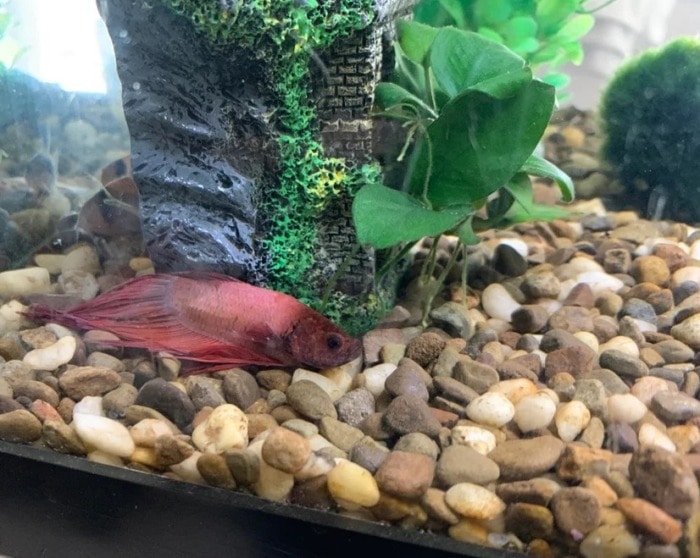
by coo_guy82
Sometimes, it’s not a lack of sleep but rather a lack of motivation.
If the front pelvic fins are moving and supporting a Betta that’s sitting on the bottom of its tank, then the fish is most likely being lazy.
Laziness is a common trait of ornamental Betta fish.
Having huge fins is not always fun for swimming, so the fish eventually develops a habit of chilling at random places in the aquarium, and more often than not, this happens to be the bottom.
Monitor the behavior of your fish.
If your Betta moves around and feeds normally in-between “rests” then there’s nothing you should worry about. Anyway, getting one of the Betta hammocks I mentioned above will provide your fish with its own resting space, away from the bottom.
4. It has a malfunctioning Swim Bladder.

by TottandBean
Another reason for a Betta to remain on the bottom or even swim sideways may be the swim bladder disorder (click the link to check the extensive guide I wrote on that). The Betta fish’s swim bladder is narrowed due to overfeeding or constipation, among other reasons.
The stomach swells, hindering the swim bladder’s proper functioning.
The condition is not lethal in its nature but it makes swimming really hard for the fish.
Sometimes a Swim Bladder malfunction causes Betta fish to spend a lot of their time laying around the bottom, as they find it difficult to move.
They may also float uncontrollably to the top, but still turned sideways or even upside-down.
The disease can be treated by fasting the fish and feeding it foods that contain more fiber.
An approach I find extremely effective is to feed the betta a crushed pea or some Daphnia, which are both an excellent source of fiber. For the former – peel the pea and boil it before the offering.
You should fast the fish for at least 1 day (24+ hours) after that.
Be sure to clean the tank of pea leftovers, as cooked peas can make a mess in the aquarium’s water.
Using Daphnia is pretty straightforward and the preferred choice among aquarists.
Personally, I also prefer to feed my Betta some Daphnia as it is a natural source of fiber. Betta fish are carnivorous and that’s what they would eat if they were in the wild.
To avoid constipation and, consequently, Swim Bladder malfunctions I recommend feeding your Betta with high-fiber foods at least twice a week. The other type of bloating can be avoided if you soak any pellets for 2 to 3 minutes or so before feeding them to your Betta fish.
This allows the food to swell outside of the fish’s stomach.
Don’t forget you need to soak them in aquarium water, or at least one that has been dechlorinated. For extra constipation-prevention diversify your Betta’s menu by feeding it bloodworms (a type of water flea larvae) occasionally.
Bloodworms are another food that replicates the natural diet of a Betta fish. An organic diet may help it fight off disease and make its bright colors stand out more.
5. Filter current is too fast.

by Kenzielauren8
Some may argue that Bettas don’t really need a filter because they can get tired quickly if the output current is too strong for their oversized fins. Though the part about Betta fish not needing a filter is wrong, it’s definitely recommended to go for a sponge filtration in smaller fish tanks of 5 or fewer gallons.
That’s unless your aquarium kit comes with a built-in filter, which usually isn’t too strong.
Most selectively bred Betta fish have massive fins that make swimming in more turbulent water difficult.
So if your Betta seems less active and prefers to relax on the bottom of its tank, try tuning down the filter’s water circulation.
Not every filter has a flow-controlling valve, but many do. My success for a 10-gallon single Betta tank has been with this such one filter (link to view it on Amazon) which has the adjustable flow feature.
Being able to control the flow in a small tank has made my pet friend twice as active. For small fish tanks that hold between 3 and 5 gallons of water, you can likely get away with using a cheap sponge filter such as this one.
For my larger tanks that include a betta or other community fish with large fins, however, I am quite satisfied with using the AquaClear Power Filter 50. In my opinion, the last one crushes the competition on price tags that come with the same functionalities.
Both HOB filters work pretty well with my super poly-fil hack, by the way (link goes to my article on that). Anyway, if you can’t get a filter with an adjustable flow rate right now, there are several DIY approaches you can try:
- Strap a bio bag or any other kind of filter media on your filter’s water outlet. You can use a rubber band, fishing line, or a cable zip tie to secure its placement.
- Disperse the flow from the filter. Although you can get awfully creative here, I can confirm two easy and efficient ways to do that:
– Tank divider kits are super cheap and will provide you with the perfect flow baffle and the means to attach it. Mount the mesh in front of the flow outlet.
– Use a brand new plastic soap dish. Soap can be toxic to fish, so go and get a new cheap one from Walmart. They usually come with holes that are perfect for spreading the flow of your filter. Of course, go for the ones with suction cups.
- Block the flow with plants or decoration. A well-planted tank will provide a safe place for your betta, away from the mean filter flow. You can also block the current with rockwork or artificial caves.
- Drill holes in the intake pipe of your filter. This is simple physics. More holes or a larger intake pipe will reduce the pressure and therefore slow down the flowing current.
Note: It has been the case that I get asked if Betta fish need a filtering system quite often (more than I would like to admit). Betta fish produce waste and do need filtration.
Canister filters still hold the #1 place when it comes to maintaining decent water conditions.
If you’re planning on getting one, use a spray bar as an outlet.
These filters provide a strong flow rate, which needs to be spread out when dealing with long-finned fish. Browse some options and mind that you should not use them in aquariums with less volume than 10 US gallons.
6. Water is too cold.
Naturally, as with any other cold-blooded creature, a Betta won’t tolerate cold water.
They are tropical fish and thrive in waters with a temperature of 75 to 82 degrees Fahrenheit (24 to 28 in Celcius).
When the water is too cold, their metabolism gradually slows down.
This causes them to become lethargic and spend a lot of time at the bottom of an aquarium.
Slowly raise the temperature if you think this may be the problem. If by any chance the aquarium does not have a heater do some quick research on the best heaters for tanks that hold between 3 and 10 gallons of water and get one as soon as possible.
7. Its water too hot.
In summer an aquarium can get really hot.
Warm water releases oxygen too quickly which may leave your Betta gasping on the bottom.
Though Betta fish possess a special organ called Labyrinth, allowing them to breathe atmospheric air, they still may die if the water is poorly oxygenated.
In this case, you have to lower the temperature and add some extra oxygen to the tank:
- Lowering the temperature – DON’T use ice packs or ice cubes in the water.
The sudden temperature change will stress both your pet fish and the good bacteria in the aquarium and, perhaps, even kill them. What you can do is place a fan to blow directly on your aquarium’s water surface.
Another (obvious) solution would be air-conditioning the room.
You could also eliminate any direct sunlight reaching the aquarium.
Don’t keep the fish tank lights on for over 6 hours, which should be more than enough for your aquatic plants to grow. Note that LED lights emit little to no heat, so get one of those if you have the chance (hint: the link will help you with that).
- Oxygenating – Use a small air pump to help with bringing more oxygen to the fish tank.
8. Old Age.
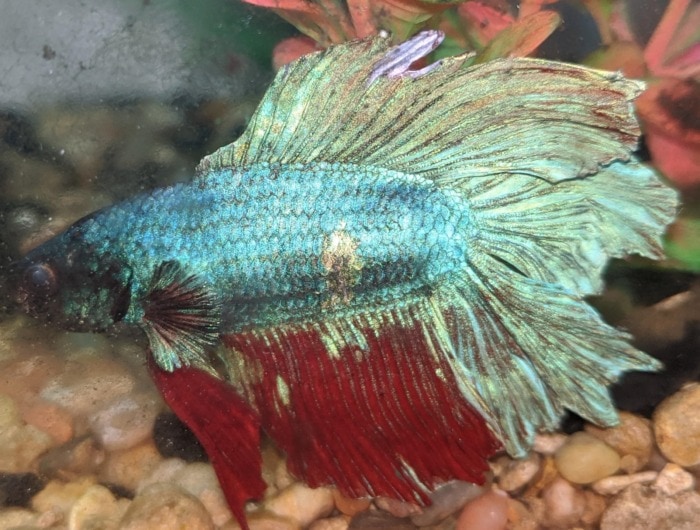
by Catharsistar
Betta fish can live a happy and healthy life for about 4 to 5 years with good care.
Some may live even longer, but after hitting the 5-year mark they will become lethargic and more susceptible to disease.
Older Betta fish won’t have that youngster energy to explore.
They will prefer laying around on leaves or the bottom of your fish tank. If the lethargic behavior of your betta is coupled with heavy breathing, lack of appetite, or body swelling, it may be time to consult a vet. The combination of these signs can often indicate a betta is about to die.
9. High ammonia levels.
If your betta is breathing heavily while laying on the bottom then the fish tank may have an ammonia issue.
Ammonia spikes can be quite deadly to aquarium fish, so you need to confirm this as soon as possible.
Confirming an Ammonia poisoning is really simple – test your fish tank’s water. An excellent way to consistently monitor the ammonia in a fish tank is using Seachem’s Ammonia Alert sensor.
It accurately tracks ammonia levels continuously and it lasts for almost a year, which is impressive, given that it only costs around $7.
Finding the roots of the problem, however, can be more complex.
A couple of reasons for high ammonia may be:
- An overstocked tank – the fish produce too much waste for the beneficial bacteria to handle.
- Overfeeding – this is so because food waste turns into Ammonia.
Monitor how much your betta actually consumes and offer less food than it can eat in one feeding session. Also, research how much and how often you should feed your fish for optimal long-term results.
A good prevention of overfeeding is getting an automatic feeder.
It will feed the fish just the right amount, even when you’re out of town. I can recommend this one on Amazon, as it’s an Eheim and it seems to work consistently.
- Incomplete tank cycling – you’ve added the Betta before the aquarium was ready to harbor live fish. Tank cycling is when you leave the beneficial bacteria enough time to develop a colony in their new tank. In return, they will transform the dangerous ammonia levels into way less harmful Nitrates and your new pet fish won’t be in danger.
A fully cycled fish tank shows readings of 0 ppm of Ammonia, 0 ppm of Nitrite, and 10 or more ppm of Nitrate.
Full, natural cycling takes no less than a month. You can speed that process up to just about 2 weeks if you’re using bottled bacteria to kick start the Nitrogen cycle (learn more about that by clicking the link to see the guide I wrote).
The good news here is that you can almost always fix high ammonia levels by doing water changes. Your initial water change should be no more than 50%.
Dechlorinate the new water before putting it in the tank by using a water conditioner such as Seachem’s Prime and continue to perform a 20% water change every week.
10. Stress or Disease.
There are a number of diseases that put a fish on the bottom of its tank.
If you still haven’t found the solution to your problem then I have bad news for you.
Pay attention whether the hanging out at the bottom is combined with atypical behavior, weird white spots appearing on your betta’s body, loss of coloration, cloudy eyes, inflamed fin patches, etc.
If any of those is true then your betta is probably sick and you should be concerned. All of these symptoms indicate something more than a lazy personality.

by wilddogslushie
If it’s a female betta with a swollen belly and you’ve concluded it’s not constipation then it may mean that the fish is eggbound.
Sometimes this condition sorts itself out, but not every time.
If that’s the case, then little can be done. Note that this is just one of the reasons for a bloat in Betta fish.
Anyway, if you suspect an infection then treating with Epsom salts can be beneficial.
You can also let some Indian Almond leaves sit in the water.
They will release tannins, which help with infections and strengthen the immune system of your fish.
However, the best thing to do if your fish seems like it’s about to perish is to make sure your tank’s water parameters are in check. A stress-free environment for your betta can also make the difference.
One quick yet absurdly efficient way to reduce stress levels in betta tanks is by adding up some live plants.
These will artificially recreate the betta’s natural environment which may be a significant help in keeping stress at bay.
I recommend the addition of surface water plants that remain afloat if you think your betta may be stressed out. They filter the aquarium water from excessive organics, provide interesting surroundings for exploration, and also get as close to the betta’s native rice paddies as possible.
Oh, and they look great.
11. Its Aquarium is too small and the fish feels confined.
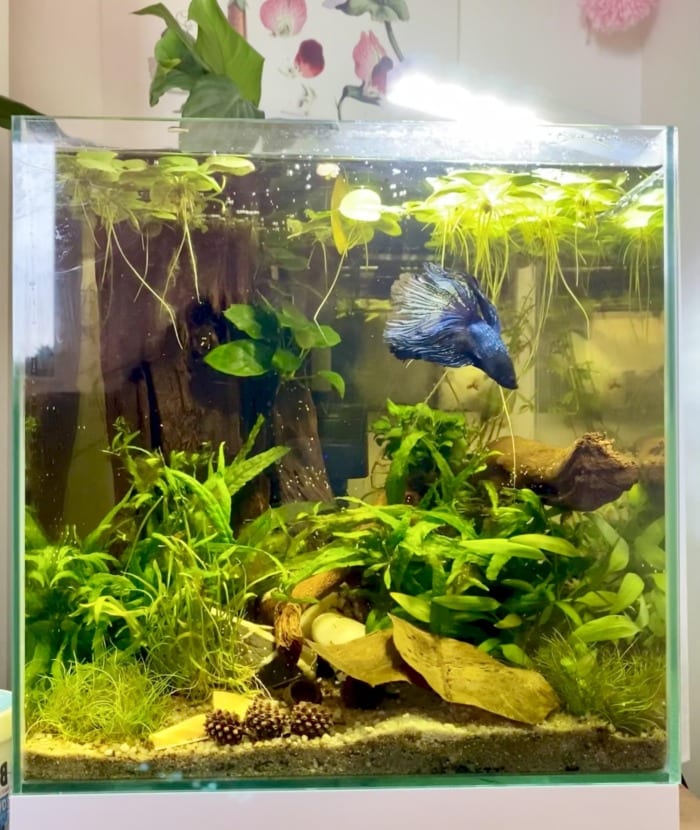
by Razzyxcxc
Although Bettas are among the smallest fish in the hobby keeping yours in anything under a 3-gallon tank may mean it’s time for a change.
The size of a 3-gallon tank is the BARE MINIMUM for a Betta fish. Ideally, you’d keep this fish species in a 5 or 10-gallon tank to allow for more free roaming. An argument to upgrade would be that smaller tanks are very difficult to keep in check.
Each small change in the water’s parameters can immediately throw the whole system off balance and your Betta will have nowhere to retreat to.
“Dilution is the solution to pollution.”
Anyway, another point I’d like to make is that, as mentioned above, Betta fish are curious, and also like their private space.
When the aquarium is too small and there’s no space to explore or retreat to, the stress may start to show.
Your betta will lose its life spark and it may prefer to do nothing but stay on the bottom.
Remember that in their natural habitat betta fish have a ton of horizontal space to swim in.
They are found in rice paddies and though shallow, these always provide more room to discover or a good hideout.
So, in case your betta tank is no more than 2-gallons in volume I would strongly suggest that you consider getting it a larger home.
Make sure the new place has LOTS of plants as well. I can help with choosing the right aquarium with this guide.
Good luck. The larger tanks also give the opportunity to house more than just a betta.
12. Sudden shift in water parameters after a water change.
Despite our best intentions, we sometimes end up doing more harm than good to our aquatic pets.
This often happens when we neglect a small detail in a simple routine we’ve done millions of times before.
Since water changes are one of the most frequent maintenance routines, we often tend to gloss over them.
Such missteps on our part, however, can seriously affect the health of betta fish and put them at the bottom of our tanks.
Apart from the temperature fluctuations I’ve pointed out, a water change may also sink a betta by altering water chemistry. This mostly happens because of osmotic shock.
If you perform a large water change in a fish tank with elevated levels of nitrate, you run the risk of sending your fish into osmotic shock.
Even though nitrate buildup can poison fish, most species can tolerate certain amounts of it.
When fish adapt to the increased nitrate levels, their bodies start retaining a higher amount of (NO₃-) ions.
The amount they retain, however, isn’t equal to that of the surrounding water.
As a result of this polarity, the surrounding water tries to suck out the nitrate ions from the fish’s body through osmotic pressure.
Fortunately for betta fish, mother nature loves balance so it protects them through a process called osmoregulation.
The powers of osmoregulation, however, aren’t unlimited.
In a polluted tank, the sudden shift in nitrate levels is so big that it overpowers the fish’s osmoregulation and sucks out its nitrate ions.
Apart from the bloating that may be observed, this stresses out the betta and may lead to unusual behaviors such as sitting at the bottom of the tank.
Related Read: Why Do Fish Die or Get Stressed After a Water Change?
My Conclusion

To witness a betta peacefully laying at a fish tank’s bottom is not uncommon.
It’s all about knowing your fish and its habits.
Carefully monitor its behavior and conclude whether it’s just a way of living or an issue in disguise.



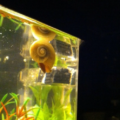


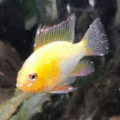




90 thoughts on “Betta fish Laying at the Bottom of the Tank: 12 Reasons Why”